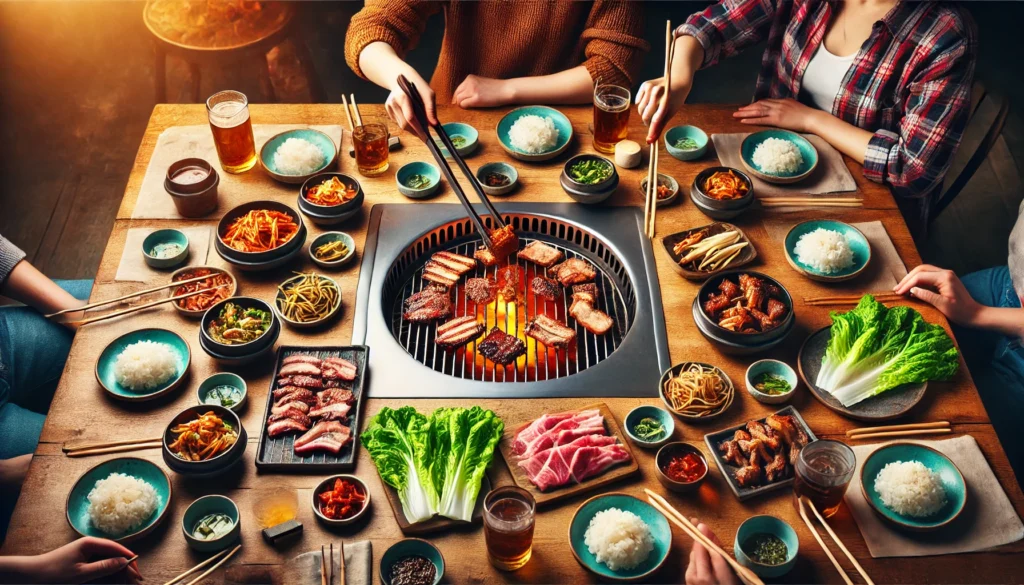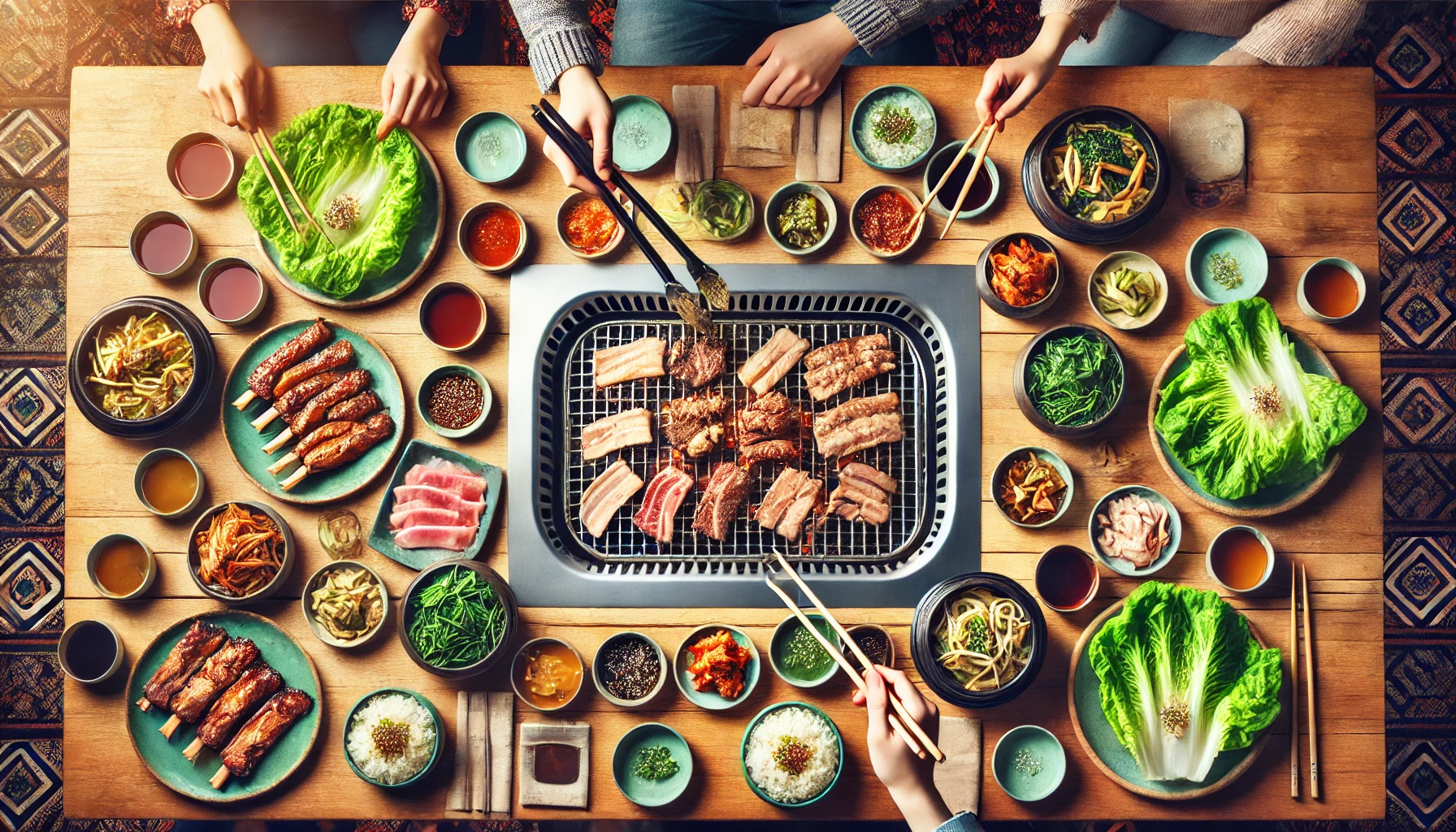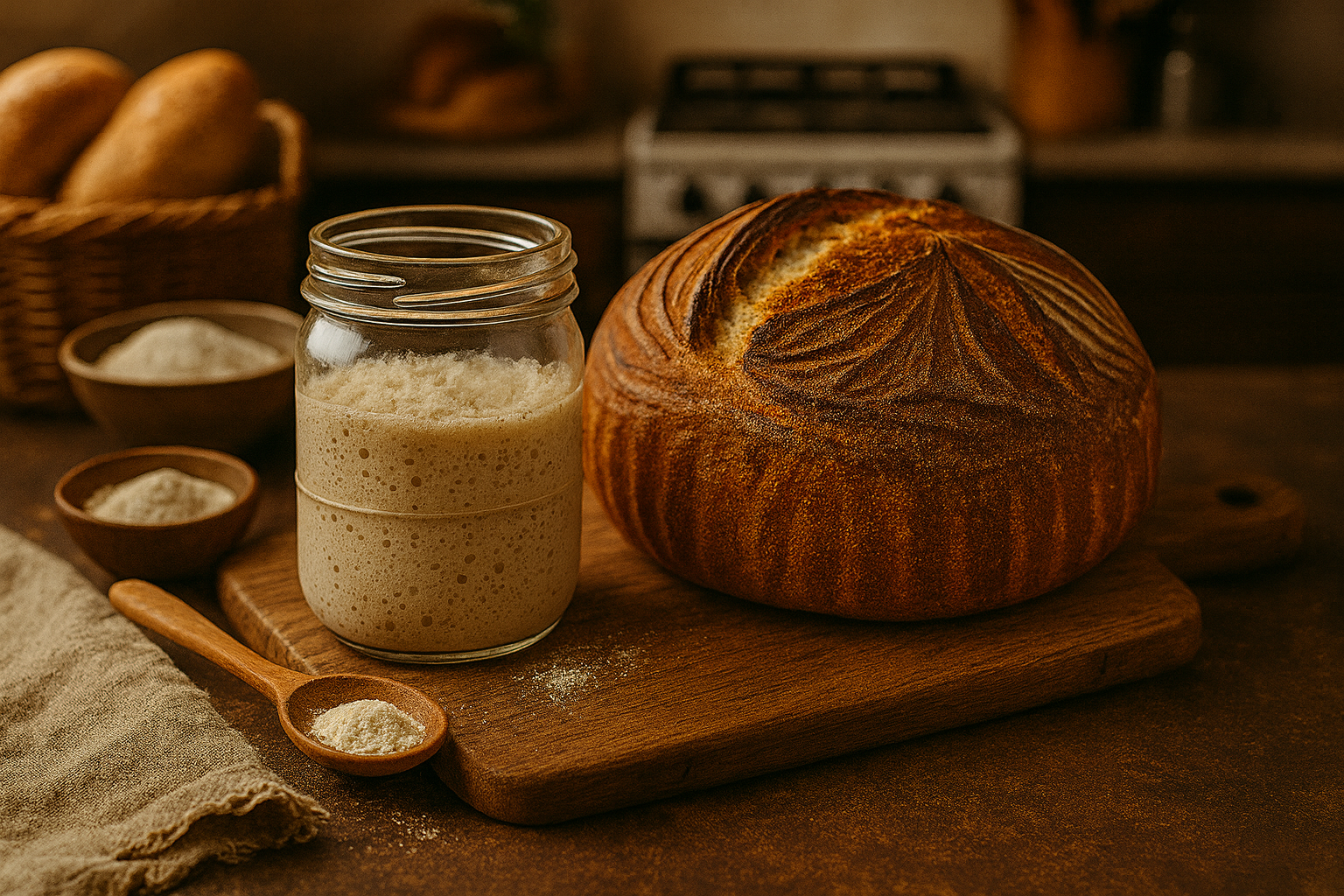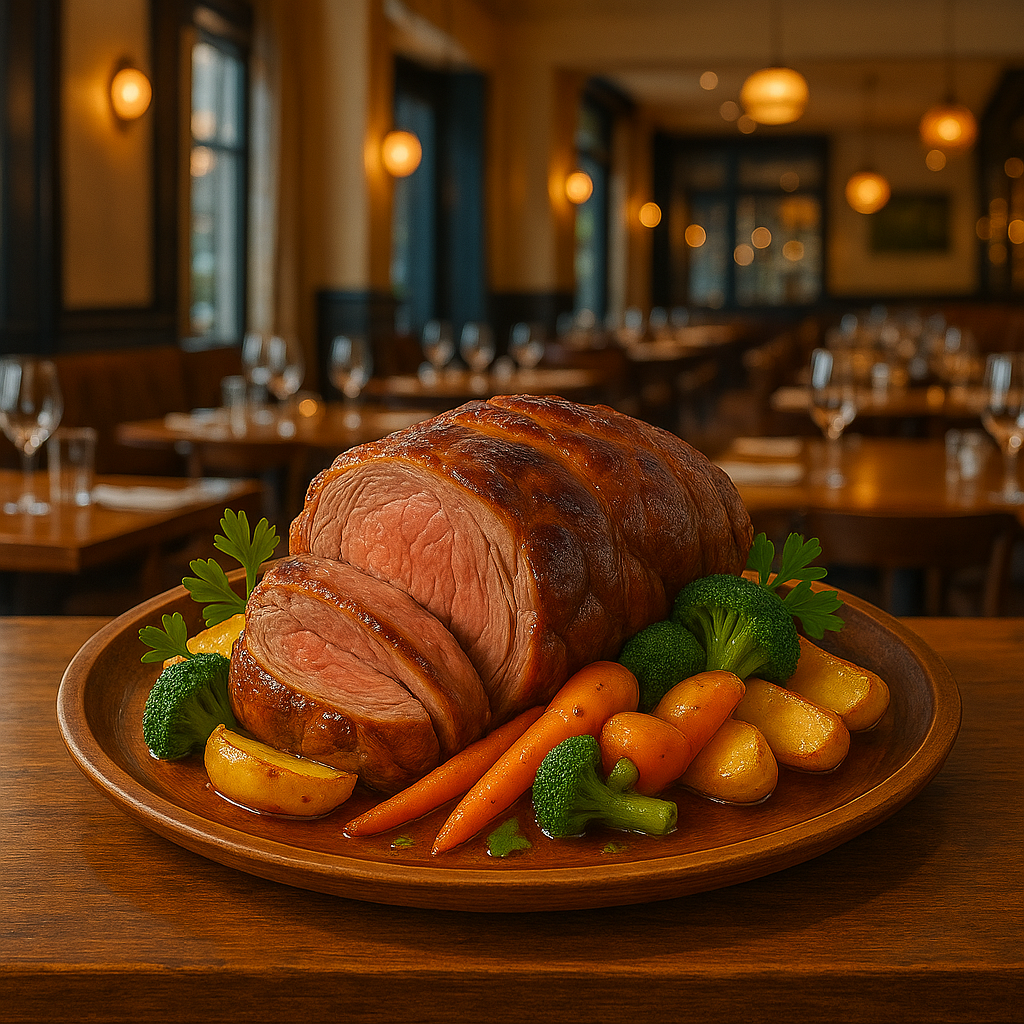What is Korean BBQ?
Korean BBQ, known as “gogigui” in the Korean language, represents more than just a meal; it embodies a rich cultural tradition that has evolved over centuries. This unique dining experience centers around grilling various types of marinated or unseasoned meats at the table, allowing diners to participate actively in the cooking process. Typically, diners cook their choice of pork, beef, or chicken on a grill built directly into the dining table, promoting an interactive and engaging atmosphere.
The cultural significance of Korean BBQ is profound, reflecting the values of community and togetherness that are central to Korean society. Meals are often shared among family and friends, fostering bonds and creating a sense of belonging. This communal aspect is further enhanced by a variety of accompanying side dishes, known as “banchan,” which are served alongside the main course. These side dishes can include pickled vegetables, kimchi, and various salads, complementing the rich, bold flavors of the grilled meats.
In terms of culinary tradition, Korean BBQ has evolved significantly. Historically, grilling was primarily reserved for special occasions, but today it is widely accessible and enjoyed across various settings, from casual gatherings to upscale restaurants. The preparation of the meat often involves marinades that include ingredients like soy sauce, garlic, sesame oil, and sugar, enhancing flavors while tenderizing the meat. Additionally, the advent of modern technology has led to innovations in grilling methods, including electric grills and charcoal options that cater to diverse preferences.
Overall, Korean BBQ represents a vibrant fusion of tradition, communal dining, and culinary artistry. The combination of interactive cooking, flavorful ingredients, and shared experiences contributes to its rising popularity not only in Korea but also around the world, drawing enthusiasts eager to embrace this unique grilling culture.
Essential Ingredients for Korean BBQ
Korean BBQ is a culinary experience characterized by its vibrant flavors and unique cooking methods. At the heart of this delightful cuisine lies a selection of essential ingredients that elevate the grilling experience. Firstly, the choice of meats is paramount. Popular options include beef, especially cuts like bulgogi (marinated slices) and galbi (short ribs), which are known for their tenderness and rich flavor. Pork belly, or samgyeopsal, is another favorite that is grilled and enjoyed with a variety of dipping sauces.
In addition to the meat, marinades play a crucial role in enhancing the flavor profile. A traditional marinade may consist of soy sauce, sugar, garlic, and sesame oil, which combine to create a sweet and savory taste that penetrates the meat. Other variations exist, often tailored to regional preferences or specific family recipes, each adding its own distinctive spin. Vegetarians can also indulge in Korean BBQ, with options like grilled mushrooms, zucchini, and tofu readily available.
Korean BBQ is rarely served alone; it is accompanied by an array of banchan, or side dishes, which are essential to the meal. Common examples include kimchi, seasoned spinach, and pickled radishes, each providing a burst of flavor that complements the grilled items. These small dishes are not merely accompaniments; they are integral to the overall experience, adding texture and variety to the meal.
Additionally, the use of dipping sauces can significantly enhance the dining experience. One popular sauce is ssamjang, a paste made from soybean paste and chili paste, perfect for pairing with grilled meats and vegetables. Together, these essential ingredients create a wonderful symphony of flavors that define Korean BBQ, making it a beloved choice for many food enthusiasts and a rich cultural tradition to enjoy.
Essential Equipment for Korean BBQ
To fully immerse yourself in the experience of Korean BBQ, investing in the right equipment is crucial. Various types of grills can be used, each offering distinct characteristics that contribute to the authentic grilling experience. The most common options are tabletop grills, charcoal grills, and gas grills. Tabletop grills are particularly favored for their convenience, allowing diners to cook at their tables, which promotes a communal atmosphere. These grills often come with a non-stick surface, making them easy to clean and ideal for cooking marinated meats.
Charcoal grills are a traditional option that imparts a unique smoky flavor to the meats. They require more time and effort to set up and manage, as they involve lighting charcoal and maintaining temperature. However, many enthusiasts argue the rich flavor achieved through charcoal grilling is unrivaled. Conversely, gas grills offer ease and control, often featuring adjustable heat settings for precise cooking. They are quick to heat up and can be easily turned off when grilling is complete, making them a practical choice for those who prefer a straightforward grilling experience.
In addition to the grill, certain cookware is essential for a successful Korean BBQ. A good-quality grill plate or pan can help distribute heat evenly, ensuring that the food is cooked to perfection. Korean BBQ often features sides that are grilled alongside the main meats; thus, having a variety of grill tools, such as tongs and spatulas, will streamline the cooking process.
Finally, utensils such as chopsticks, serving platters, and dipping sauce bowls enhance the dining experience. Overall, the right equipment not only simplifies the grilling process but also elevates your appreciation of this delicious and hearty cuisine. With the correct setup, anyone can enjoy grilling like a local.
Preparing the Meat: Marinades and Seasoning
The preparation of meat is crucial in achieving an authentic Korean BBQ experience, with marinades playing a significant role in flavor and tenderness. Two of the most popular marinades are bulgogi and galbi, each offering distinct taste profiles that enhance the meat’s natural qualities.
Bulgogi, often made with thinly sliced beef, features a marinade that combines soy sauce, sugar, sesame oil, garlic, and black pepper. The blend of sweet and savory elements is essential for creating the dish’s signature flavor. To prepare bulgogi, mix these ingredients in a bowl, ensuring the sugar dissolves completely. Marinate the beef in this mixture for at least 30 minutes, though a duration of two to four hours is recommended for deeper flavor penetration. For optimal results, marinate overnight in the refrigerator, allowing the enzymes to tenderize the meat thoroughly.
Galbi, typically made with short ribs, requires a marinade that enhances the hearty flavor of the beef. A common galbi marinade consists of soy sauce, sugar, garlic, and fruit-based components such as pear or apple, which adds a natural sweetness and tenderness to the meat. To prepare, blend the ingredients until smooth. The marinating process for galbi should be similar to that of bulgogi; allow it to soak in the flavorful mixture for at least one hour, with a preference for longer marination of up to eight hours to achieve optimal tenderness and taste.
While preparing the meat, it is important to consider the cut and texture, as different types of meat may require variations in marinating time and seasoning. Other cuts like pork belly or chicken can also be enjoyed in Korean BBQ, often complemented by simpler seasonings such as salt and pepper. Understanding these marinades and seasoning techniques is essential for any beginner seeking to grill like a local and enjoy an authentic Korean BBQ experience.
Setting Up Your Korean BBQ Experience
To create an authentic and enjoyable Korean BBQ experience, careful planning and setup are essential. Begin by selecting a suitable location for your grilling. A well-ventilated area, such as a backyard or patio, is ideal as it allows smoke to disperse easily, providing a comfortable environment for everyone. If indoors, ensure you have an exhaust fan or open windows to maintain air circulation, as the grilling can produce a significant amount of smoke.
Your table arrangement is also crucial for a successful Korean BBQ. Use a sturdy table that can easily accommodate your guests, along with the necessary equipment. A portable grill is a common choice; traditional Korean BBQ often utilizes charcoal or gas grills to infuse a smoky flavor to the meat. Place the grill at the center of the table to encourage interaction, as guests can cook their own meat at their preferred level of doneness.
Next, consider the serving dishes. Prepare small plates or bowls for each guest, ideally traditional Korean earthenware or vibrant ceramics. These can be used for the grilled meats as well as an array of accompanying side dishes known as “banchan.” Common banchan options include kimchi, pickled vegetables, and seasoned bean sprouts, all of which offer a delightful contrast to the grilled meats. A selection of sauces, such as sesame oil with salt and gochujang (Korean chili paste), should also be readily available for dipping.
Finally, creating a warm and inviting atmosphere can significantly enhance the dining experience. Candles, subtle lighting, and pleasant music can contribute to the ambiance. As guests gather and cook together, the shared experience fosters a sense of community, making the Korean BBQ not just a meal, but a social occasion. By focusing on these elements, you can ensure a memorable and enjoyable evening filled with delicious food and lasting memories.
Grilling Techniques and Secrets
The essence of Korean BBQ lies not only in the marinades and accompaniments but also in the grilling techniques that elevate the meal. One of the primary methods is direct grilling, which involves placing the meat directly over a heat source. This technique allows for an immediate sear, enhancing the flavor and creating a desirable crust. To achieve optimal results, it is crucial to preheat the grill to a high temperature before placing the marinated meats on it, ensuring a quick cook without losing moisture.
Understanding the right temperature is essential when grilling Korean BBQ. For thin cuts, such as bulgogi or galbi, a high temperature around 200°C (392°F) is ideal, enabling rapid cooking in just a few minutes. Conversely, thicker cuts like pork belly or beef chadolbaegi require lower temperatures and longer cooking times to ensure that they are cooked evenly and remain succulent. Monitoring the internal temperature of the meat during grilling can also help ensure that it is cooked thoroughly while being careful not to overcook it.
Another aspect to consider is the timing and flipping of the meat. A common mistake is flipping the meat too frequently, which can disrupt the searing process. Instead, allow the meat to cook for a few minutes on one side before gently flipping it over. This not only helps in achieving those beautiful grill marks but also retains the juices within the meat. Additionally, it is advisable to manage the grill effectively by arranging different types of meat according to their cooking times and temperatures. For instance, cooking quick-cooking items simultaneously with those that take longer ensures a well-orchestrated grilling experience.
By mastering these grilling techniques and secrets, anyone can enhance their Korean BBQ experience, making it both enjoyable and delicious.
Pairing Drinks with Korean BBQ
When enjoying the delightful experience of Korean BBQ, the choice of beverages plays a significant role in enhancing the overall dining experience. Traditional drinks such as soju and makgeolli are popular choices that perfectly complement the robust flavors of grilled meats and savory side dishes. Soju, a distilled spirit with a clean taste and a slightly sweet finish, pairs wonderfully with various marinated meats, particularly bulgogi and galbi. The alcohol content of soju typically ranges from 16% to 25%, making it a versatile option that can be enjoyed either neat or in cocktails, such as the refreshing soju sour.
Another noteworthy beverage is makgeolli, a traditional Korean rice wine that offers a unique contrast to the savory notes of BBQ. With its milky appearance and slightly effervescent nature, makgeolli adds a creamy texture and light sweetness that enhances the grilled flavors without overwhelming them. This drink, with a lower alcohol content than soju, is often recommended for those seeking a more balanced pairing, especially alongside spicy or fatty dishes.
For those who prefer non-alcoholic options, traditional Korean beverages like sujeonggwa, a cinnamon and ginger punch, or a simple barley tea, can also elevate the Korean BBQ experience. Sujeonggwa provides a refreshing sweetness and unique spices that cleanse the palate between bites, while barley tea, served both hot or cold, contributes a nutty flavor that complements grilled meats well. These beverages allow diners to enjoy the array of flavors in Korean BBQ without the influence of alcohol.
Overall, selecting the right drink to accompany Korean BBQ is about balancing flavors and enhancing each bite. Whether opting for traditional alcoholic options like soju and makgeolli or exploring non-alcoholic choices, the right beverage will undoubtedly enrich the culinary experience and deepen the appreciation for this beloved cuisine.
The Role of Banchan in Korean BBQ
Banchan, a delightful assortment of side dishes, plays a crucial role in the traditional experience of Korean BBQ. These small, flavorful servings are not merely accompaniments; they are integral to the meal, enhancing both the dining experience and the overall flavor profile of the grilled meats. Common banchan varieties include kimchi, pickled vegetables, seasoned greens, and tofu, each carrying its unique flavor and texture that complements the smoky richness of the barbecue.
The preparation of banchan typically involves a variety of ingredients and techniques, showcasing the vibrant culinary culture of Korea. For instance, kimchi, a fermented dish made predominantly from napa cabbage and radishes, is seasoned with chili pepper, garlic, and ginger, delivering a tangy, spicy kick that balances the savory flavors of grilled meat. Meanwhile, pickled vegetables often add a refreshing crunch and a hint of sweetness. These side dishes are usually served in small portions, allowing diners to sample multiple flavors throughout their meal.
In addition to being flavorful, banchan also contributes to the communal aspect of Korean dining. Diners are encouraged to share these side dishes, fostering a sense of togetherness as they enjoy a diverse range of tastes. As the main event, the grilling of meats unfolds, the banchan serves to refresh the palate and enhance the overall enjoyment of the meal. The harmonious blend of grilled meats and banchan not only highlights the culinary ingenuity of Korean cuisine but also reinforces the cultural traditions of sharing and togetherness during meals.
Enjoying Korean BBQ Like a Local
To truly enjoy Korean BBQ and immerse yourself in this culinary experience, it is essential to understand the dining etiquette and cultural practices that accompany it. Korean BBQ is not just a meal; it is a communal experience that encourages sharing and interaction. As you sit at the table, expect to see a grill at the center, where an assortment of marinated meats and vegetables are cooked to perfection, signifying the social nature of the meal.
One of the key aspects of enjoying Korean BBQ is the practice of serving one another. It is customary to take turns grilling meat and serving pieces to your dining companions. This not only reflects the spirit of togetherness but also allows diners to engage in the convivial atmosphere. When serving food, it is polite to use shared utensils rather than your personal chopsticks. This simple gesture emphasizes respect and consideration for others at the table.
In addition to sharing food, being attentive to the communal side of dining enhances the experience. If you notice someone’s meat is nearly finished, it is thoughtful to offer them more, maintaining a generous spirit throughout the meal. Furthermore, Korean BBQ often includes an array of side dishes, known as banchan, which can be shared among guests. Sampling different kinds of banchan alongside the grilled meats enriches the overall meal and showcases the variety of flavors present in Korean cuisine.
Embracing the experience of Korean BBQ also means adopting the cultural mindset that celebrates enjoying food together. Conversations, laughter, and the shared act of grilling contribute to a joyous atmosphere that defines this unique dining tradition. By participating fully and engaging with those around you, whether in a restaurant or at a friend’s home, you will not only savor delicious flavors but also create lasting memories consistent with the spirit of Korean hospitality.






